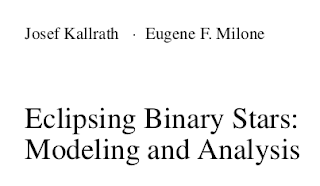Iapetus: photometric light curve (brightness versus orbital phase, brightness versus time)
Galilean moons: photometric light curves (brightness versus orbital phase, brightness versus time)
Eclipsling binary star systems: topic TBD
For the moon photometry, the idea is to keep the data collection short and sweet. There's no particular reason to sit on the targets more than about 10 minutes. That'll allow me enough time to get a decent statistical sample while all the moons are at a single orbital phase. So observing Saturn and Jupiter will literally take about 30 minutes plus setup time.
Along with that, I'll collect photometric data on a selection of eclipsing binary stars. I just got the ebook: "Eclipsing Binary Stars: Modeling and Analysis" by Josef Kallrath and Eugene F. Milone. It seems comprehensive enough to be able to give me a pretty decent idea about what direction I want to take and what data will have to be acquired either by myself or from various surveys.
The computer saga: Let me tell you a computer story. About two years ago I bought a fairly new computer to replace one I've had for a while that I've been using as my 'research computer'. This is where I have all of my working data, along with all my software to do the data reduction and analysis. The new computer arrived and within the first week the ethernet adapter (on the motherboard) got zapped by a lightening strike. So there was no way to have a wired ethernet connection. Ok, so I switch to wifi with a little USB ethernet dongle. I got the computer set up and configured, and installed all the python stuff so I could start my switch from IRAF to the various astronomical python packages that are now available.
One day the system asked if I wanted to upgrade the OS. I figured this was a good time to do that, so I went ahead with that. After the upgrade, no matter what I did I couldn't get the wifi to work! So now I have a pretty decent machine but no reasonable way to get data in and out of it!
I found another computer that had windows 7 on it. I decided to replace the hard drive with the one from my new computer. This went well for a couple days until THIS computer decided that it didn't want to power up anymore. It just sat there and clicked!
Needless to say, I was pretty bummed out. So I put all these computers away and sort of forgot about them. Thinking about this new research and still wanting a newer computer to do the work, I started thinking about either getting yet another new computer, or figuring out how to cobble together something with the pieces I have.
I also had acquired a new wifi USB dongle.
This past weekend I pulled everything out. I put the original new machine back together (less one memory stick which I can't find, so I only have 2 GB of memory at the moment), plugged in the new wifi adapter and VOILA the machine came up and connected to my wifi! So yay now I have a working machine with some decent processing power. I'd like to get at least 8 GB of memory on this machine.

